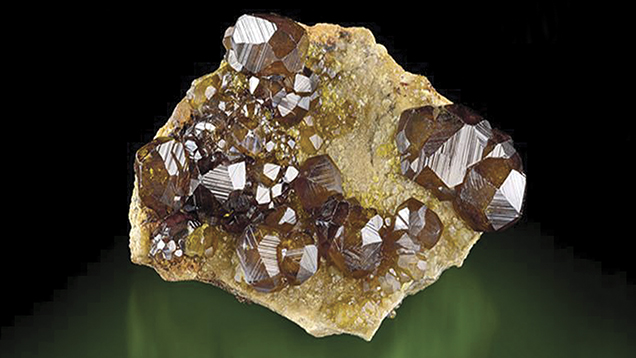First Discovery of Topazolite in Mexico
In January 2014, during mineralogical investigations of Mexican garnet, we made the first reported discovery of fine topazolite crystals in Mexico. These yellow to yellow-brown crystals, measuring 1.5–2.5 cm, are hosted by the Las Vigas skarn deposits (the Cerro de la Concordia mine in Las Vigas de Ramirez municipality and the Piedra Parada mine in Tatatila municipality). The deposits are located in Veracruz State, about 50 km southeast of the town of Valle de Veracruz.
The garnet composition was determined by electron microprobe, using a 41-point analysis and standard conditions of 20 kV, 20 mA, and 1 µm beam size on a JEOL JSM-35c microprobe. We chose a euhedral, relatively homogeneous crystal about 1 cm in diameter from the specimen shown in figure 1. Measurement time was 30 seconds on the peak center. The standards used were MgO for Mg, Al2O3 for Al, jadeite for Si, wollastonite for Ca, and elemental Fe and Mn. The electron microprobe analyses showed little compositional variation or zoning. We calculated the structural formula on the basis of 12 oxygen atoms, with the assumption of all iron as ferric. The approximate composition averaged (Ca2.86Mg0.06Mn0.02)2.94(Al1.20Fe3+0.72)1.92Si3.03Ti0.05O12, which may be expressed as Gr60.50And36.70Py2.80.

Figure 1. This topazolite specimen is from a recent discovery in the Mexican state of Veracruz. Photo by Cristobal Castillo.
UV-visible spectroscopy showed absorption bands at 375, 416, 442, 497, and 584 nm, which can be assigned to the spin-forbidden crystal-field transition of Fe3+ substituted on the octahedral Al3+ site of the garnet structure. The correlated set of these bands also show a pattern close to that characteristic of a d5 trivalent ion in octahedral oxygen coordination. The Mössbauer spectra were characterized by a sharp, slightly asymmetric ferrous doublet. The UV-visible and Mössbauer spectra are comparable to those reported for some garnets in previous reports (A.S. Marfunin, Ed., Advanced Mineralogy, Vol. 2, Springer-Verlag, Berlin, 1995, pp. 74–75, 114).The three samples of rough topazolite (measuring 1.0–1.5 cm in longest dimension) gave the following properties: yellow-brown color; isotropic and weakly anisotropic; weak strain birefringence; RI—nα = 1.84–1.89; hydrostatic SG—3.75–3.85; and fluorescence—inert to both long- and short-wave UV radiation.
This Mexican topazolite deposit has not been mined, and in the absence of detailed geological, mineralogical, and gemological study, no estimate of the reserves is available. For now, there are no specimens or fashioned material from Las Vigas in the Mexican lapidary market.



